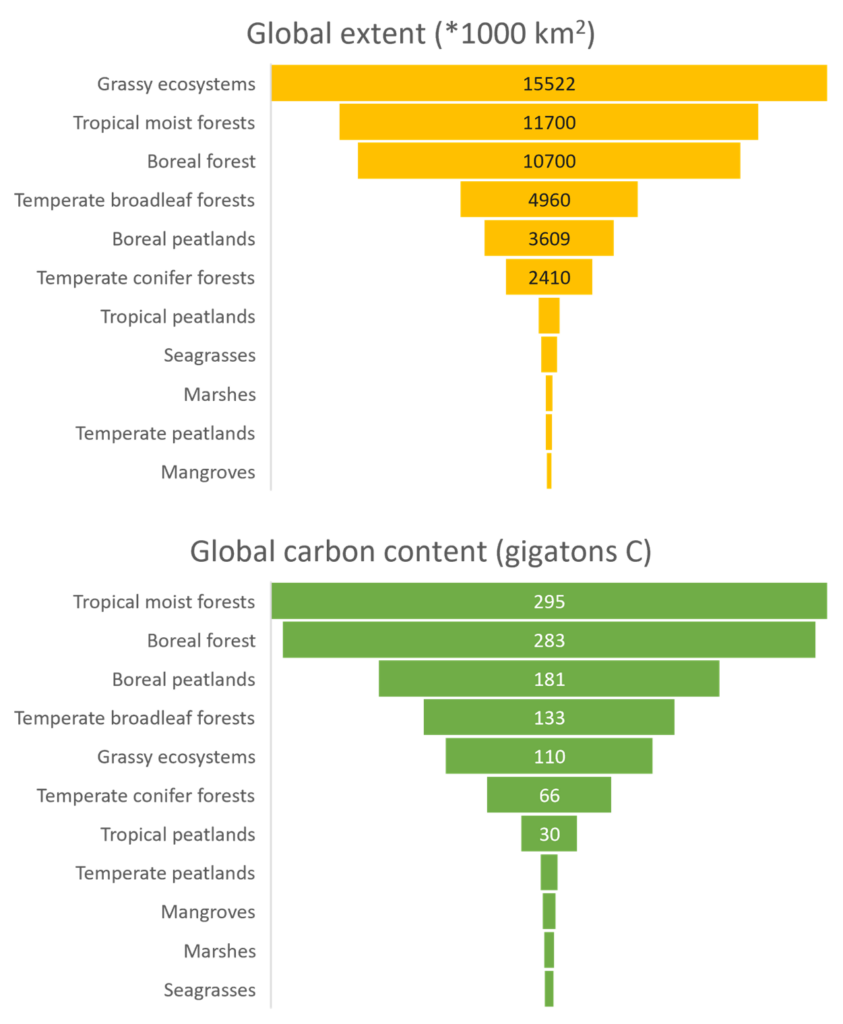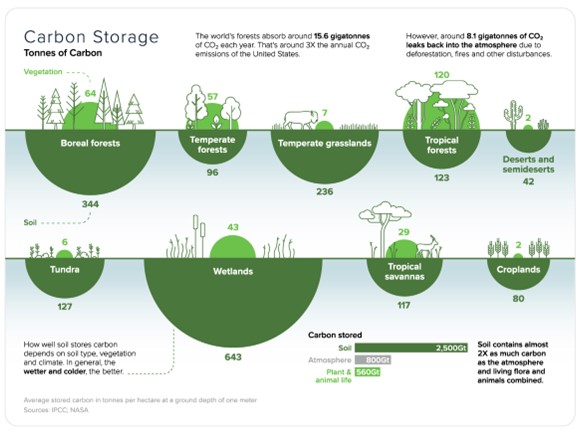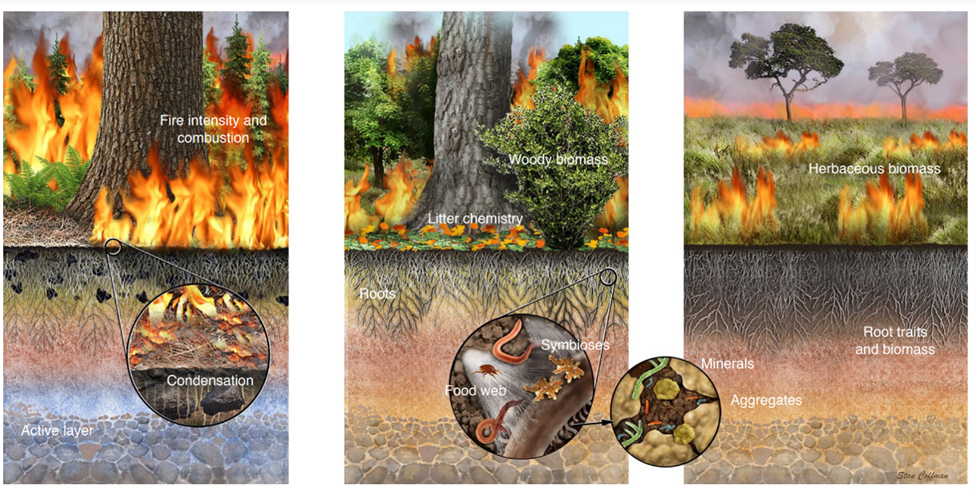We are all in a desperate race for net-zero to halt the changing climate. Plus we are in the middle of an unprecedented biodiversity crisis, e.g., wild mammals now reported to make up only 2% of the global land mammalian biomass (the majority of which is livestock).
Reaching net zero involves the reduction and removal of human-induced greenhouse gas emissions that are responsible for climate change. By now we all know that immediate and sustained cuts in our fossil fuel use is essential if we are to do this. But so far, our emissions only continue to rise. As does the destruction of natural habitat, and the two are inextricably linked. So, an approach that considers both biodiversity and climate sounds like a source of hope. Recent research has estimated that ‘nature-based solutions’ or ‘natural climate solutions’ could contribute as much as a third of the climate mitigation needed to keep temperature increases below 2°C, while having benefits for biodiversity, clean water, and air quality. Natural climate solutions aim to protect and restore natural ecosystems as well as sustainably manage agricultural lands. The towering trees of forests are a visible and impressive store of carbon, where approximately half of plant biomass can be carbon, and we have all seen disturbing footage of how wildfires can destroy these forests. It is therefore not surprising that tree planting and fire suppression are often what springs to people’s mind when it comes to natural climate solutions. But actions like these are a bad idea not only for biodiversity but also can have surprising consequences for carbon in ecosystems that evolved with natural disturbances (Figure 1).

In the effort to mitigate climate change (or appear to do so), there has been a tree planting frenzy including in grassy ecosystems such as grasslands and savanna where no trees (or fewer and different species) previously existed. This is called afforestation. This is totally misplaced for obvious reasons such as the destruction of open ecosystems supporting some of the last charismatic wildlife on the planet, e.g., elephant, rhino, giraffe, and buffalo that graze and/or browse here. Less obvious is that afforestation of grassy ecosystems threatens the significant carbon storage in these areas. Even more surprising is that the natural disturbances with which these ecosystems evolved, herbivory and fire, play a role in creating and maintaining stable forms of soil carbon. This calls into question the suppression of these disturbances in carbon offset schemes, which as we shall see, requires a more nuanced approach. Let’s dig a bit deeper into each of these ideas.
Grassy ecosystems: More carbon than you might think
Although grassy ecosystems only have moderate carbon stocks globally (about 390 t C ha-1) compared to peatlands, mangroves or some forests, their geographic extent is vast and so their contribution to the world’s carbon is surprisingly high around 9% (Figure 2). This is greater for example than temperate conifer forests or tropical peatlands. Of the grassy biomes, the high-altitude or montane grasslands contribute the most carbon.

Secure storage: Much of the carbon in grassy ecosystems is securely stored underground
We now know that grassy ecosystems are a more ‘reliable’ carbon sink than forested ones. The reason for this is simple: much of grassland carbon is below ground in the soil whereas forests, especially tropical forests, store most of their carbon aboveground in living biomass where it is vulnerable to loss by clear-cutting, harvesting, or burning. Belowground carbon includes plant roots, but the vast majority is found in the soil itself as soil organic carbon (SOC), the largest terrestrial store of carbon on Earth (Figure 3). Grasslands can store between 50% and 70% of their carbon in soil, while moist tropical forests store less than 50% of their carbon as SOC.

Natural disturbances help maintain open vegetation structure and biodiversity, but what about carbon?
Grassy ecosystems evolved with recurrent fires and wild mammalian herbivory. It is well known that these natural disturbances maintain open habitat and plant diversity. Also, the soils of certain high-altitude grasslands are often leached by relatively high rainfall, and thus dependent on fire for the cycling of soil nutrients needed for plant growth. It is often assumed however that fire (and herbivory) will decrease SOC. This is because of a focus on the top-down effects of fire, in other words, the direct combustion of living plants, plant litter and soil organic matter (SOM, about 50% of which is carbon), but this ignores the nuances of fire impacts.
Fire affects soil organic matter in a variety of ways and differs across various ecosystems
Fire has been a distressing topic in the news lately, with wildfire outbreaks amid rising global temperatures leading to loss of property and life. But a recent study showed that there has been a global decline in burned areas over the last two decades, mostly due to fire suppression in grassy areas. From our own work we also know that fire suppression is one reason for woody plant encroachment in sub-Saharan Africa, which reduces open habitat for wildlife. This trend of fire suppression is misplaced because it does not consider the variety of ways in which fire affects SOM and how it differs across ecosystems (Figure 4): Intense fires may well combust SOM but less intense ones can stabilize it. For example, in boreal and temperate forests, intense fires will combust SOM but low intensity fires can increase chemical stability of SOM (e.g., “black carbon”), making it less accessible to decomposition by soil microbes and thus less vulnerable to loss. Also, low intensity fire can promote understory plants and detritivore activity in temperate forests. In grassy ecosystems, fire is vital in maintaining grasses and herbaceous vs woody plants. Many perennial grasses are very fine-rooted and reach deep into the soil. Root exudates from these plants are known to increase soil aggregation and to become associated with soil minerals, both of which stabilize SOC. In fact, our most recent understanding of SOC makes clear that simple carbon compounds such as organic acids and sugars (found in root exudates), rather than being vulnerable to loss as previously thought, are very efficiently used by soil microbes and subsequently tightly bound to soil minerals. This is another pathway, besides black carbon, by which SOC can be stabilized, increasing its permanence.

From our published work and as yet unpublished studies in South Africa, we have seen that grassy ecosystems will maintain SOC levels despite regular disturbance by fire and mammalian herbivory. In fact, these levels are often the same or higher (grassland study) or slightly reduced (savanna study) compared to situations where these disturbances are supressed completely. We have recently found for example that a particularly stable form of SOC that is bound to minerals is maintained in the presence of both fire and herbivory when these are moderate (in this case every two or three years but the exact interval will be context specific). In contrast, this form of stable carbon declines with frequent (annual) fires. These trends are maintained under various future climate scenarios according to various models we have used.
Tipping points and research gaps: It’s about the intensity of disturbance
Context matters. We can expect that that animals and fire will maintain the cycling of carbon to grassland soil under moderate intensities but that as the disturbance becomes more extreme, e.g., too frequent or intense fires and/or overgrazing, that a tipping point will be reached where SOC depletes. In turn, we can expect that plant productivity will decline (as will SOC) if there are no disturbances to cycle aboveground carbon to SOC. Also, excessive aboveground biomass due to fire suppression could promote larger, hotter fires vs cooler fires with regular controlled burning.
While some data exist, we lack a nuanced understanding of where this tipping point occurs in different grassy ecosystems. There are also some overlooked members of the carbon cycle, such as underground symbiotic soil fungi, the contribution of which may be large, as our recent review shows. Very likely, fire and herbivory interact with these and other carbon pools in ways we have yet to understand. Models are useful for exploring multiple scenarios that are impossible to test in field experiments, e.g., the impact of many grazing/fire intensities on SOC. However, the most well-developed models are not always based on the most recent soil science, making them less reliable than we would like. Clearly, there is no shortage of questions for future research.
Afforestation and fire suppression in grassland carbon offset projects are strongly misplaced
However, what we do know is that the increased pressure to afforest and suppress fire in grasslands is misplaced. Afforestation is being strongly contested in grassy biomes and there is increasing awareness of this. However, there is still increasing pressure to suppress fire in grasslands as part of carbon offset projects. For example, land users adhering to one of global ‘gold standards’ concerning the management of grasslands for carbon offsetting recommends a reduction in grassland burning to once every five years. But these guidelines ignore what might be an appropriate fire return for that area as well as the most recent understanding of how fire affects SOM.
Socioecological and conservation outlook: potential of wilder grasslands
Of course, people are part of grassy ecosystems and have been for hundreds of years. There is a lot that livestock owners, conservationists and pastoralists can do sustainably manage these ecosystems. Firstly, it is clear that adaptive management matters, e.g., reducing stocking rates when drought is expected, or burning an area that is encroached by woody plants. Secondly, the stocking rate must be aligned with the carrying capacity of the area. We now know from multiple studies that the grazing approach (animal density, number of paddocks) is much less important than the stocking rate. Finally, there is an interesting opportunity to both replenish our dwindling diversity of animals, while also potentially increasing carbon removal and/or reduction in greenhouse gas emissions. More evidence is needed before we can generalize, but there is intriguing evidence that large wild herbivores such as elephants can help mitigate climate change.
Perhaps real hope for the future of grasslands and indeed the planet can be found if there are significant and sustained cuts in fossil fuel use, and if ecosystems, including grasslands and their natural processes, can be maintained and protected in an equitable way.
Heidi Hawkins is a Friedman Fellow at Conservation International and an Honorary Research Associate at the University of Cape Town.
She will be taking part in the upcoming 16th OGRC Tipping Points webinar about managing Africa’s grassy biomes, on 31st August at 1pm (CAT). Register here to listen in to this discussion.
Author
- Just cut fossil fuels and leave our grasslands alone! - August 14, 2023
Additional News
Pangolins are elusive and heavily trafficked. At Tswalu, researchers are working to uncover their secrets and aid conservation.
Declining Sparrow-Weavers may threaten other birds that rely on their old nests for shelter.





